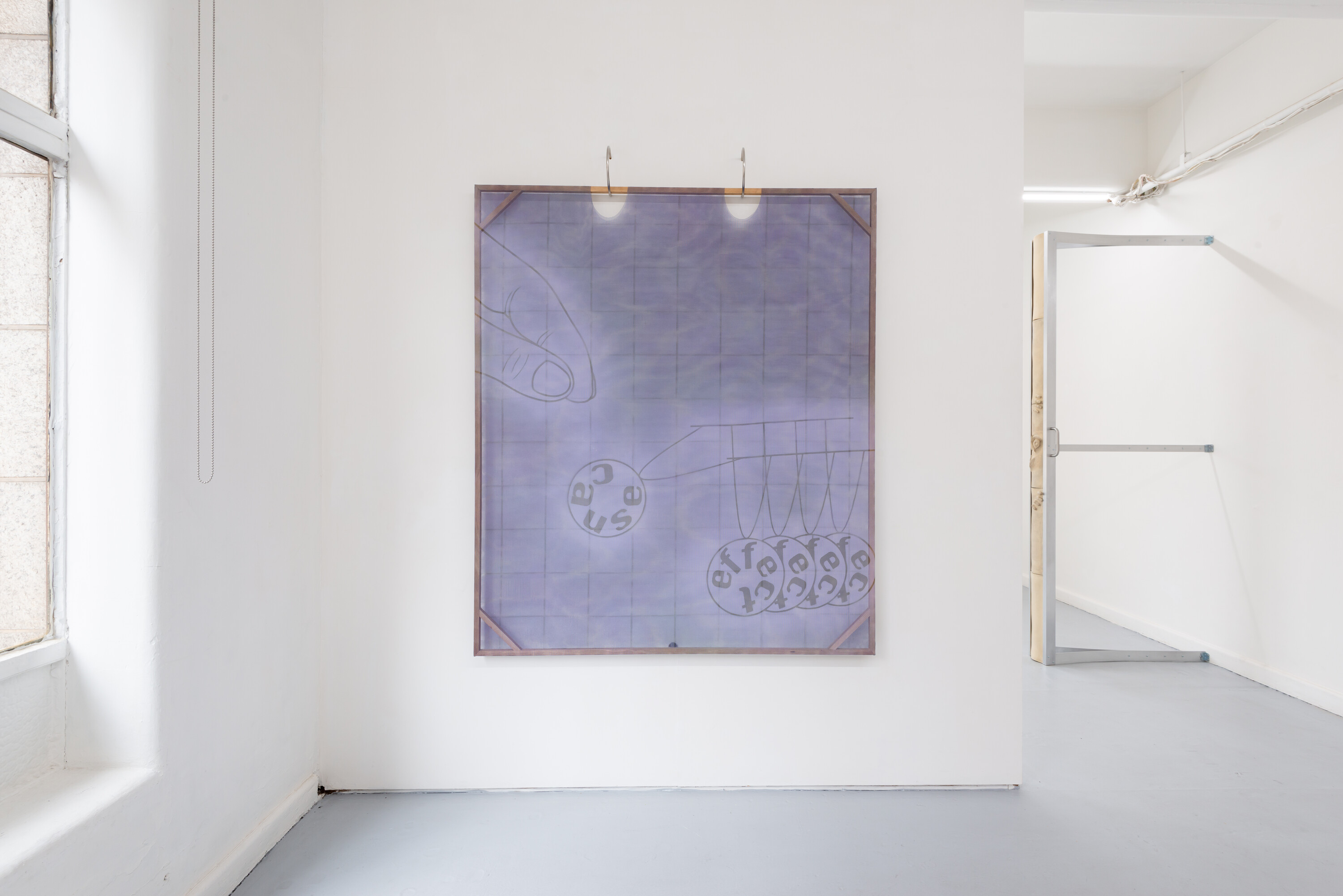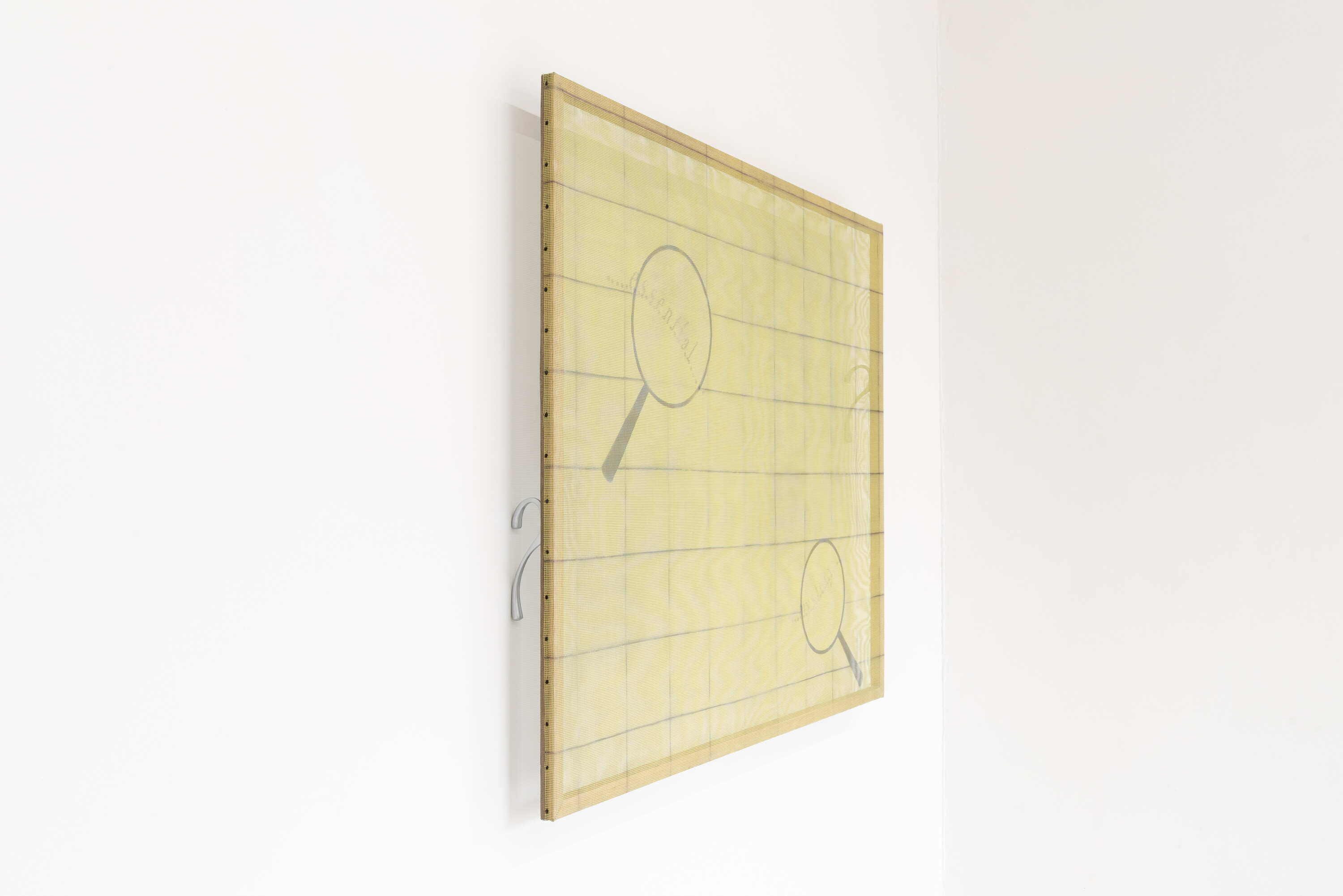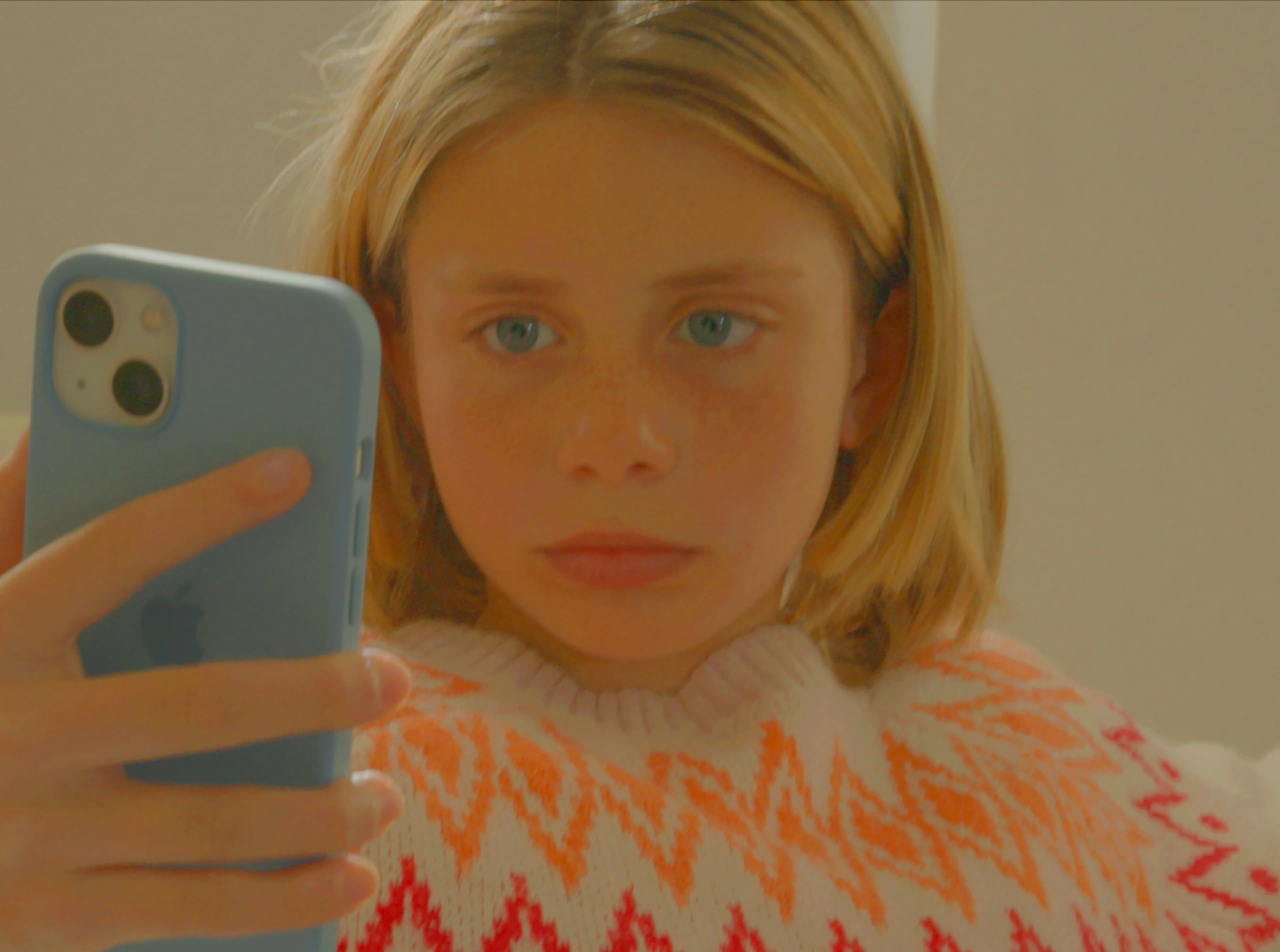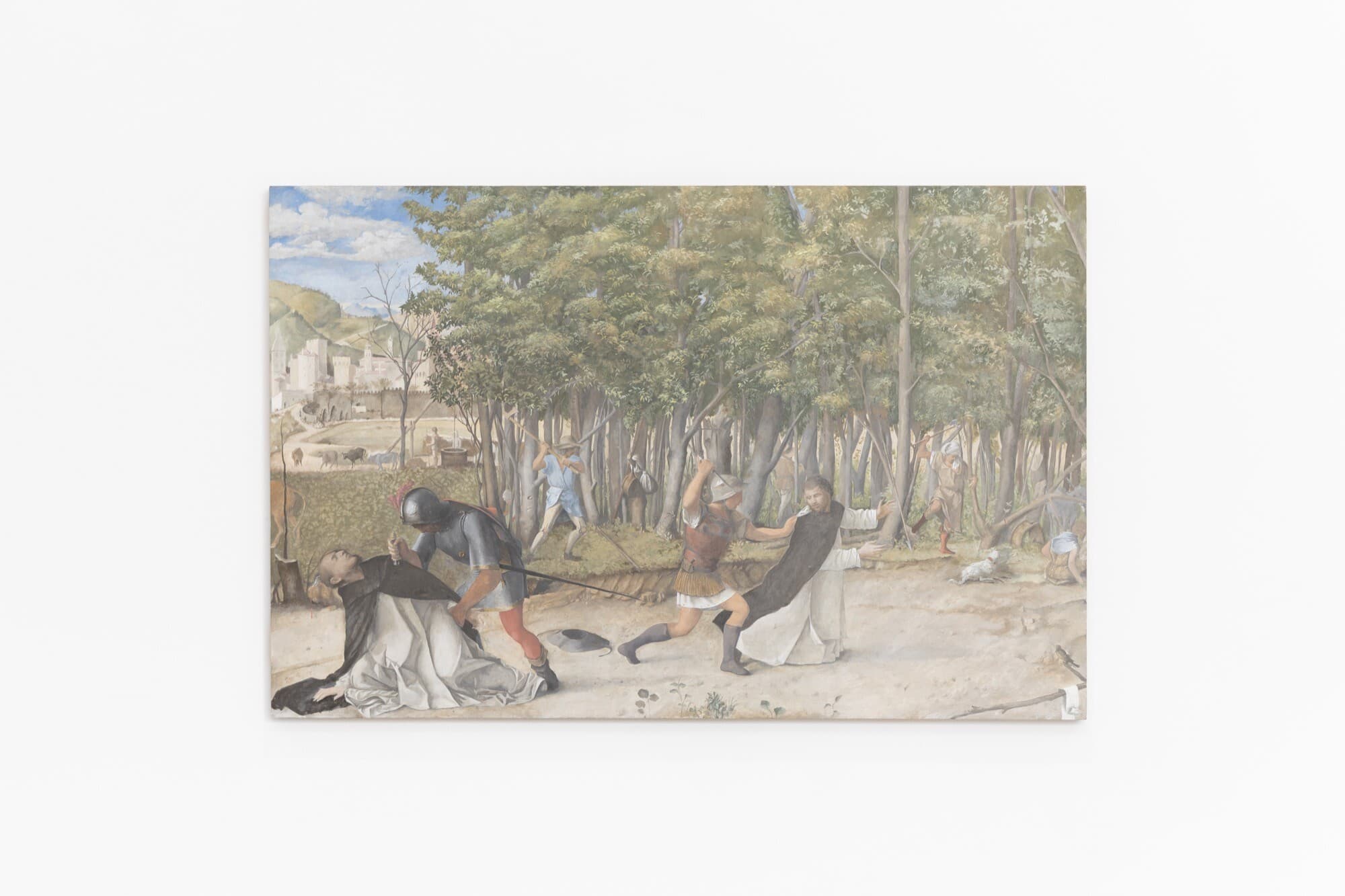Katie Ryan, attendant (b), 2024, Office chair parts, 32 x 28 x 26cm. Courtesy of the artist and CAVES. Photo: Sebastian Kainey
Katie Ryan: desk, door, devil
Diego Ramírez
Katie Ryan’s desk, door, devil is an exhibition about little people making big decisions in secluded offices. There is something reminiscent of the civil servants in Tim Burton’s Beetlejuice who become underworld case workers after committing suicide, in her demonic references. The show notoriously features a devil trapped in an aluminum door frame, accompanied by readymades of ergonomic chairs and drawings imitating diagrams. Located at the artist-run space CAVES, on the eighth floor of the Nicholson Building, the show blends in disturbingly well with a plethora of neighbouring CBD offices, where we can see people sitting for extended hours, slowly increasing their risk of deep vein thrombosis. Peering through the art deco windows of the oh-my-god-so-creative Nicholas Building, I swear it looks like they are using Windows 1992 on their computer screens. But I suspect Ryan’s aesthetic predilections for objects like the executive ball clicker in the purple drawing Newton’s Cradle (2024), which broadly fits with an idea of yuppie culture, is influencing this view.
desk, door, devil’s notion of bureaucracy as hell reminds me of C. S. Lewis’s, author of The Chronicles of Narnia (don’t laugh), complaints about managerialism. In his over-the-top preface to the 1961 edition of The Screwtape Letters, he proclaims that the most heinous crimes are “conceived and ordered (moved, seconded, carried, and minuted) in clean, carpeted, warmed, and well-lighted offices, by quiet men with white collars and cut fingernails and smooth-shaven cheeks who do not need to raise their voice.” Lewis’s fixation on the politeness and cleanliness of bureaucracy is as hilarious as it is familiar, for it bears an uncanny resemblance to the pristine white cube many arts administrators desire. Indeed, putting a thing in an empty room is a simple proposition, until one realises that these spaces are layered with managerialism: KPIs, statements, committees, protocols, and procedures. Kill me. Pronto. Form after form, log in after log in. I’m one Google Doc away from becoming a civil servant in the next Beetlejuice remake.
The most impressive work in the show is The Door Problem (2024), where a ceramic devil is bursting out of a door’s edge. Made of aluminium, the work is drilled to the wall, offering a bizarre perspective where the front of the sculpture depicts the door’s side—and the side of the sculpture represents the front. This perceptual game reminds me of how the brain resets as we cross thresholds, making us wonder why we entered a room (or what we were looking for in the fridge). This simple distortion also brings gravity to Ryan’s demonic apparition, where the devil is opening the insides of the door like a monster bursting out of a womb, as it creates the illusion that Satan is bending reality with his presence as he penetrates our earthly realm. Indeed, this nightmarish creature is opening the door from within, curving the sides of the door to accommodate its cursed mass, with cartoonish yet chilling effect. Its face made of stoneware bears the brutishness of b-grade horror, blinking an eye as it exits a hell mouth of its own horrible making. The anatomy of the door itself resembles a skeleton, for the it appears fleshless without surfaces to enclose its front and back.

Katie Ryan, The Door Problem, 2024, aluminium, stoneware, wood, MDF, chrome paint, fixings, 240 x 99 x 25cm. Courtesy of the artist and CAVES. Photo: Sebastian Kainey
Ryan also “flips sides” in terms of how she imagines hell as an elevated office, rather than an underground lair. The most obvious connection with the devil as a doorway is the medieval hell mouth, where the entrance to inferno is rendered as the gaping mouth of a predatory monster. This orifice was the entrance to the loins of the Judeo-Christian underworld, which borrowed from Hades to manufacture an abyss of eternal suffering. Unlike these exotic scenes, where the opening reveals episodes of torture and pain, Ryan’s Door Problem is cold and restrained. However, it shares a great deal with the hell mouth in terms of how it offers a view of suffering—as the skeletal frame of the door allows full view of whoever is standing beside it. This corporate version of hell has more in common with the governmental capital of Pandemonium in Paradise Lost (1667), where Lucifer holds councils with his legion of demons to reach consensus against heaven, by way of a manipulative democracy. This image resonates with Ryan’s notion of evil as centralised decision making, fitting a revision of the devil as power.
Viewed from the front, the door handles resemble those of a briefcase. The kind to appear in a Robert Longo painting, where white-collar workers are posing in quasi-poetic ways that are incredibly embarrassing to witness. There’s also something Al Pacino in The Devil’s Advocate (1997) about the way it connects suitcases with evil, echoing C.S. Lewis’s belief that the greatest crimes happen in offices. While it’s tempting to compartmentalise bureaucracy as a governmental or corporate phenomenon, it’s something that also unfolds in interpersonal relationships. According to David Graeber, corporate bureaucracy has infiltrated everyday life steadily since the ’90s, in the form of personal development and healing discourses that speak of optimisation. I feel for people who are dating now and use spreadsheets, minutes, and resolutions to schedule meetings and resolve conflict after the “polycule turn,” demonstrating how we have continued to embrace instruments of managerialism.
Incorporated artist-run spaces also bear the traces of this corporatisation, despite their moralistic proclamations and aspirations to radicalism. According to Brett Jones, co-founder of West Space, in An Ideology of Space (2004), this shift began in the ’80s, when funding bodies drew a distinction between contemporary art spaces and artist-run initiatives, to make more bureaucratic demands to recipients capable of meeting them. Alongside inflation in the real estate market, he believes artists became more competitive in this economy, embracing bureaucracy to work with government. Jones foresaw that artist-run organisations would become progressively more administrative, operating under protocols and procedures that began to break away from the foundational ideas of an artist-run model altogether.

Installation view of Katie Ryan, desk, door, devil, CAVES Gallery. Courtesy of the artist and CAVES. Photo: Sebastian Kainey
Artist and writer Tamsen Green hilariously echoed this conversation years later in Boxcopy’s publication Run Run Run Run Run (2009), where she put forth that her committee was made of sub-committees, organised as “Installation and Maintenance” Studio, PR and Media (with IT), Education, Finance, Volunteer, Publication, Flash Night (that’s one-night shows), and International Relations (really).” Managerial subjectivities aggravate this issue today, as protocols and procedures become part of networked identities: the eagerness to exist and conduct oneself as an administrator, splitting the self into sub-committees of friendship, care, and love. Starting a random and innocuous conversation with, “do you have the capacity today?”, illustrates this point. Because it’s more emotionally taxing to hear this fake care protocol for friends than the chat itself. Like, just talk.
The film Problemista (2024), directed by Julio Torres (also the protagonist), exemplifies this by drawing a parallel between the bureaucracy of US immigration and multinationals and the administrative demands that an art critic played by Tilda Swinton (who engages him as an intern) places on Torres’s character. For instance, Swinton makes Torres file her husband’s paintings in an obscure and outdated spreadsheet software. The art critic represents the internalisation of bureaucratic processes and their spillage into everyday life, as she creates rules that match the absurdity of public servants and large corporations. Even though she continually trespasses public and private boundaries herself, bullying her way past structures and procedures. Torres faces similar issues as he interacts with the government, the bank, and the art critic, demonstrating how these entities share bureaucratic devices, such as an overemphasis on timelines, instructions, standards, and technicalities. desk, door, devil appears to make a similar suggestion, by turning the white cube into an office that draws on an equivalence with the real offices that surround it.
Hmmm, galleries resemble offices and sometimes they also have a lot of office in them. CAVES only has a sitting desk (and I also happen to know very little about the space), granting desk, door, devil a rare sense of neutrality. This lends itself to “commenting on” rather than “commenting in” by turning the critical gaze upon itself, which is becoming an increasingly rare commodity in a saturated public life with a surplus of meaning. This is to say that a couple of artist-run spaces have offices as large as gallery rooms, and we live in a TMI culture that makes everyone behind the scenes develop a reality-show complex, meaning that a project like this would inevitably resonate as an imitation of the administrative processes that facilitate its showing. These proportions would make a hilarious update to Michael Asher’s 1974 work at Claire S. Copley Gallery—where he removed the partition between the gallery, the office, and the store room to create one large room—making an awkward commentary on the shifting figure of the arts administrator (sitting nearby) as well as the cultural policy-making that scaffolds its existence. desk, door, devil operates at a broader level instead, allowing audiences to connect its criticism to a wider panorama. It’s about middle and upper management affecting the composition of everyday life.

Installation view of Katie Ryan, desk, door, devil, CAVES Gallery. Courtesy of the artist and CAVES. Photo: Sebastian Kainey
attendant (a) and attendant(b) are two sculptures made of armrests from office chairs, positioned in front of two large flyscreen drawings. The ergonomic readymades are turned upside down and assembled to resemble feet. There is something undeniably visceral about their design, evoking the intestinal roundedness that permeates medical and sexual instruments. These anal connotations inevitably make me think of hemorrhoids, triggered by long sitting hours. In proximity to The Door Problem, attendant (a) and attendant (b) resemble minions in a white-collar inferno. It’s easy to imagine them as spectral entities or fill the gaps of their appearance, since the rest of their bodies are missing. Perhaps their punishment is sitting down without stretching breaks, drafting long emails, or filling time sheets that require multiple log ins. The design of the armrests creates the illusion of life by resembling feet, thus imbuing them with a magical aura. It feels like a black magician animated them, trapping souls to torture them with eternal calf exercises. This resonates with attendant (a) in particular, as Ryan playfully arranged one “foot” forward, to make it seem like it was walking in stasis.
Both flyscreen drawings imitate the stark aesthetics of graphs and charts. Loosely evoking the windows that give office workers a sense of embodied humanity, as well as playing with the notion of Windows as an operating system, these works have grids in ode to spreadsheets. In the first room, Newton’s Cradle depicts an ominous finger reaching out for an executive ball clicker that reads “cause” and “effect.” Ryan describes it as a godly encounter that acknowledges the concentrated power of governance. While in the second room, essential mystery shows two magnifying lenses amplifying the words “essential” and “mystery.” It has a Where in the World is Carmen Sandiego? (1985) flair about it, proposing that the data hides an enigma to be deciphered. Ryan’s minimal use of paired words in the drawings strikes me as a mockery of a high-level executive summary—here abbreviated to the point of intangibility.

Installation view of Katie Ryan, desk, door, devil, CAVES Gallery. Courtesy of the artist and CAVES. Photo: Sebastian Kainey
Behind the drawings are fixtures that append the works to the wall, echoing their contents. Newton’s Cradle has large rings that reference the spheres in the executive ball clicker, albeit hollow. This emptiness is a significant commentary on the connotations of the ball clicker, which represents the cause and effect of decision making. Power lies within the resources that the decision maker is guarding, rather than the individual itself, which is reiterated by the mass-produced nature of this object. Since power relies on infrastructures to function and something needs to be hoarded to support its flow, there is a shallowness to its force. If resources are emptied, power ceases to exist. essential mystery’s fixtures seem to extend this critique by mimicking a question mark. What resources are of value here? Who grants and denies access to them? Where are they? While this may strike one as a paranoid reading, administration entails the need to manage an asset. And whoever is in greater proximity to its core is of larger influence.
From the devil’s head to the fingers, there are fragments of a body in this admin station. These parts suggest the totality of a worker, who is implied rather than shown. The spectator can project multiple identities upon this absence, ranging from an artist to an administrator, to a CEO, to a public servant. One could say this invisibility points to the unrepresentability of bureaucracy as a single entity, for it is an atmospheric force that inhabits social, institutional, and cultural systems. It reflects the pictorial trajectory of the devil as a hybrid monster to a humanoid fallen angel, whilst moving towards a psychopathic human that carries evil within, such as American Pyscho’s Patrick Bateman. The “literally me” coinage that incels use to describe these movies, to express how they’re about to explode from loserdom, reflects this dispersion of evil into a collective state. In this state of diffusion, something so present as bureaucracy undoubtedly becomes invisible. Ryan takes advantage of the everywhereness of bureaucracy by signposting its presence through parts rather than wholes, allowing the viewer to fill in the blanks.
Diego Ramírez is an artist with dreams, a writer with hopes and a facilitator with beliefs. He is represented by MARS Gallery and is currently undertaking a PhD at Monash University.


